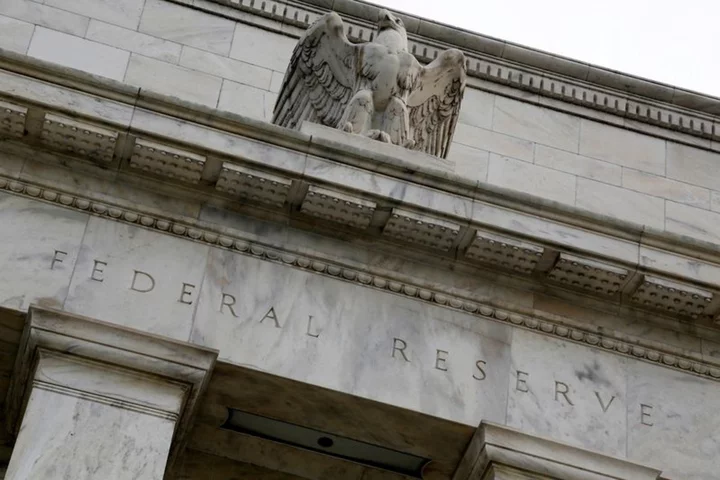By Jamie McGeever
ORLANDO, Florida If signals from the U.S. bond market prove accurate, the Fed will be successful in getting inflation down to a '2 handle'. Just not its 2% target.
Moves in bond yields, implied inflation breakeven rates, and inflation-adjusted 'real' yields suggest investors anticipate the Fed's 'higher for longer' interest rate policy will help lower inflation to around 2.5%.
The moves currently underfoot in the bond market are dramatic. But this is not a re-pricing of the Fed's near-term trajectory, rather a repricing of the longer term economic and inflation outlook.
Annual consumer price inflation around 2.5% could legitimately be considered a success - it was 9% in June last year - especially if the hallowed economic soft landing is achieved and a painful recession is avoided.
Policymakers would probably bite your hand off for that scenario but never admit it. They will insist policy be set to get inflation down to 2% which, crucially for markets, implies there will be no easing, as investors had long expected.
"The risk of inflation staying higher than where we want it is the bigger risk. We ought to have 100% commitment that we're going to get inflation back to target," Chicago Fed President Austan Goolsbee told CNBC on Monday.
This suggests the Fed is entering a phase of structurally higher rates than perhaps policymakers themselves, and certainly investors, had anticipated.
What is curious about this is the bond market appears to accept that the economy will remain relatively hot and policy will stay restrictive for longer, yet is unconvinced inflation will get down to 2%.
Many analysts are skeptical that moves in bond yields can be broken down, quantified and compartmentalized with any great degree of accuracy. There are too many moving parts, especially further out the curve.
But interest rate strategists at Goldman Sachs have tried to break down what is behind the selloff in 10-year bonds over the last couple of months that has driven yields up more than 50 basis points to a 16-year high above 4.50%.
They attribute just under half of the rise to 'policy' - investors are finally realizing that the Fed is in for the long haul on higher rates - and about a third to stronger 'growth'. 'Inflation' and 'residual' - essentially increased supply - account for a fraction of the increase, they estimate.
GIVE AN INCH, TAKE A MILE
This fits with what inflation breakeven rates and real yields have shown in recent weeks - shorter-dated rates drifting lower and longer-dated rates rising.
Two-year breakevens are around 2.35%, up from a sub-2.00% low in July but down from a peak earlier this month above 2.50%, and the 10-year breakeven rate is around 2.40%, up from lows around 2.30% in May, June and July.
Breakeven inflation is the difference between the yield on a nominal bond and the yield of an inflation-linked bond of the same maturity. The result is traders' implicit forecast of average inflation over the relevant time horizon.
The yield on two-year Treasury Inflation-Protected Securities (TIPS) has fallen from a peak of around 3.15% in July to 2.80% now, not far from where it was at the start of August.
The yield on 10-year TIPS, meanwhile, has risen to a 15-year high of 2.20% from around 1.60% in early August, and is showing little sign of reversing.
TIPS are a key market-based barometer of investors' inflation expectations, but they have their flaws. TIPS can be highly volatile, illiquid, and driven by portfolio hedging flows more than outright directional bets on inflation.
Taken together, breakevens and TIPS suggest the inflation outlook is gradually coalescing above the Fed's 2% target.
Marvin Barth, founder of independent research firm Thematic Markets, reckons long-dated yields could rise another 150 basis points or so. "This is about inflation expectations, and they have risen."
Barth and others say the surge in long-dated yields is due to 'term premium'. That is the compensation investors demand for taking on interest rate risk over a bond's lifetime, which is in theory higher the longer the maturity.
This is contributing to a steepening - or disinverting - of the yield curve. Long-dated yields have been well below short-dated yields for over a year but the gap is shrinking fast, another sign that pessimism around the economy is evaporating.
"It's all about the term premium," says Torsten Slok, chief economist and partner at Apollo Global Management. "The worry is that despite the big move in the term premium since late July, it is still significantly below its historical average."
(The opinions expressed here are those of the author, a columnist for Reuters.)
(By Jamie McGeever; Editing by Christina Fincher)

